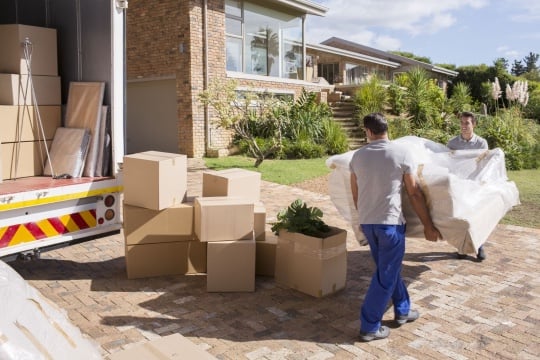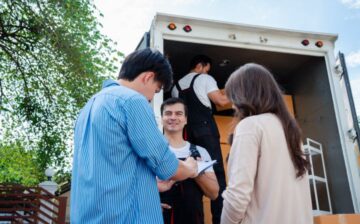Are you thinking of changing your current zip code for sunshine, coastal towns, and a fresh start in Florida? How exciting! But a long-distance move isn’t something you just want to wing. It takes real planning to avoid surprise costs, broken fragile items, and total burnout.
And if moving feels a lot for you, it’s definitely not just you. A national survey shows that 38% of people say moving is more stressful than breaking up with a significant other. That says a lot. (1)
So, if you’re relocating to Florida, you need a solid plan to avoid last-minute scrambling. Here’s what you need to plan now to make your long-distance move less chaotic.

Draft a Realistic Timeline
You need to give yourself more time than you think you need. A long-distance move is a different route, and it’s nothing like just moving across town. Ideally, you’ll need to set aside at least 8–12 weeks to get things in order without missing anything and feeling overwhelmed.
So, block off the important dates: when to give notice at your current place, when to shut off utilities, when to pack certain rooms, and your target move-in date in Florida. Once you have the main dates figured out, break them down week by week using a calendar or checklist.
Having a realistic timeline definitely helps in making your moving tasks more manageable and organized. Just be sure to build in some buffer days too, in case there are things that might throw off your schedule.
Hire the Right Moving Company
One of the biggest decisions you’ll make is choosing who handles your belongings. A long-distance move involves more logistics, more risk, and a lot more trust. You’ll want a moving company that shows up on time, handles your belongings with care, and gives you a clear quote without surprise fees.
If your destination is in the Big Guava area, it’s smart to work with a Tampa, FL moving company that specializes in interstate relocations. These professionals understand local traffic routes, unloading logistics, and regional regulations.
More importantly, you need to start your search early. The best movers tend to book up quickly, particularly during the summer. And while you do, always take time to read reviews, compare quotes, and check for insurance coverage. Hiring the right moving company can make the whole long-distance move a whole lot easier.
Purge What You Don’t Need
Don’t pay to move things you don’t even use. Remember, the more things you bring, the higher your moving bill will be. The more stuff you’ll have to unpack later, too.
Now that you’re about to move to Florida, this can be the perfect time to sort through your belongings and let go of anything that’s broken, outdated, unused, or just not worth hauling across state lines.
Packing is no easy task; 43% of people actually believe it’s the most time-consuming part of moving. So, go room by room and get real about what stays and what goes. Getting rid of unnecessary items now will make packing faster and unloading easier once you’re in Florida. You may also sell what still has value, donate usable items, and toss the rest. (2)
Research Your New Neighborhood
Knowing you’re moving to Florida isn’t enough. As much as possible, you need to know exactly where and what you’re moving into. Every city, town, and neighborhood has its own pace and personality. What feels like a good fit on paper might not match your lifestyle once you settle in.
Look into some important things like their commute times, school ratings, hospitals, grocery stores, and local safety reports. You should also consider your daily routine and what conveniences matter most. A quick Google search won’t suffice here. Ideally, you should dig deeper with forums, local groups, or even a short trip to explore the area in person, if possible.
Also, be aware of weather-related risks. Florida saw an average of 6.8 weather or climate disasters per year from 2020 to 2024, including hurricanes, floods, and severe storms. The total disaster cost in 2024 alone reached up to a staggering USD$100 billion. If you’re moving to a coastal or low-lying area, check if it falls in a flood zone and understand how that affects your insurance costs and long-term risk. (3)
Knowing what you’re walking into helps you plan smarter and not just relocate faster.
Handle Legal and Administrative Tasks Early
There’s a mountain of paperwork involved in a long-distance move, so don’t wait until the last minute to handle it. Start updating your address with banks, subscription services, and insurance providers. You’ll also need to transfer or cancel utilities at your current home and schedule them at your new one.
If you’re changing your driver’s license and vehicle registration, check Florida’s DMV website for current requirements. Some services allow online updates, but others require in-person visits within 30 days of moving. Handling these early will save you headaches and potential penalties later on.
Budget Beyond Just the Moving Truck
A lot of people underestimate how expensive a long-distance move really is. Most of the time, they budget only for the moving truck or the service fee. But other than those things, you’ll also need to budget for fuel, hotel stays, meals on the road, and temporary housing if your home isn’t ready. Plus, you could also be spending on tolls or storage fees if there’s a gap between your move-out and move-in dates.
That’s why it’s really important to draft a moving budget that includes a cushion for unexpected expenses. That way, you won’t panic if your new place needs repairs, or if you end up staying in a hotel a few nights longer than expected.
Plan Your Travel Route Strategically
If you’re driving to Florida on your moving day, your route matters more than you think. Long drives can be physically exhausting and mentally draining, especially if you’re towing a trailer or driving a packed vehicle. So, in advance, map out rest stops, fuel stations, overnight stays, and backup routes in case of traffic or road closures.
Additionally, avoid major city rush hours, and make sure your vehicle is in top shape before hitting the road. Double-check tire pressure, oil levels, and your GPS or phone battery.
Take Inventory of Your Belongings
Before the moving truck rolls out, document everything you’re moving with you. Create a room-by-room inventory list that includes furniture, electronics, and boxes. If possible, take photos of valuable items from multiple angles and keep a digital copy of serial numbers or receipts. These will serve as your proof in case anything goes missing or gets damaged.
More importantly, label every box clearly and include your name and new address on each one. This speeds up the unloading process and helps avoid mix-ups.
Key Takeaway
A long-distance move to Florida can feel exciting and overwhelming at the same time. But as long as you’re fully prepared, the whole moving project can become more manageable. Just give yourself time, stay organized, and don’t cut corners when it comes to professional help. When you plan wisely, you’ll be able to enjoy the Florida sunshine sooner than you think!
References:
- “Poll: Moving More Stressful Than Breakups”, Source: https://www.nar.realtor/magazine/real-estate-news/poll-moving-more-stressful-than-breakups
- “Is moving more stressful than divorce? Study says yes”, Source: https://journalrecord.com/2025/02/20/is-moving-more-stressful-than-divorce-study-says-yes/
- “Florida Summary”, Source: https://www.ncei.noaa.gov/access/billions/state-summary/FL .
We hope you found this blog post on Long-Distance Move to Florida: What You Need To Plan Ahead, useful. Be sure to check out our post on Moving To Florida: Tips For People Looking To Relocate for more great tips!
Have Experience in the Moving Industry? Want an Additional Income Stream? Work With All Around Moving!
Join our Work With us program, moving and relocation consultants. Partnering with All Around Moving Services helps you profit.Click here to learn more.





